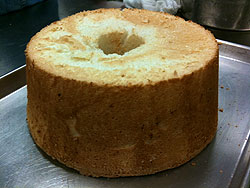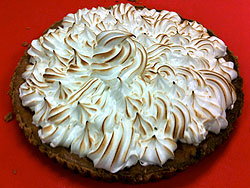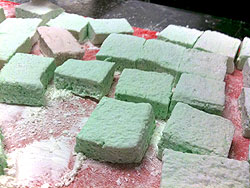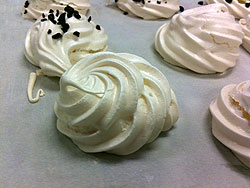
Spring break is over and class has resumed this week, with the topic being meringues. The term is French, but there is some debate as two its origin, whether or not its Swiss or German. Egg whites and sugar are the primary ingredients in the meringue. Egg whites are made up of two proteins, albumin, and ovalbumin. The albumen is responsible for creating a stable air mass when egg whites are whipped. The ovalbumin creates a stable structure when the egg whites are heated and the 85% water content in egg whites is evaporated.
Egg whites at room temperature can expand, when whipped, up to 8 times their original volume. The yolk in the egg contains fat, which is present in egg whites, will inhibit the albumen protein from whipping. If you see any egg yolk in your separated egg whites, the easiest way to get it out is to use the eggshell. The shell will act like a magnet and draw the yolk towards it, allowing it to be scooped out of the whites. The same is true of any fats present in your bowl or whisk. Be sure to use a clean metal bowl to whisk your egg whites. Use vinegar to wipe down your equipment if you are unsure. There is some debate over the effectiveness of using a copper bowl for whisking, the benefit appears to be very little if any.
When making meringue, the more sugar one uses the shinier, creamier and denser the meringue. If one uses less sugar, the meringue will be drier and dull. The sugar acts as a stabilizer and flavor enhancer, during both the whipping process and the baking process. The sugar must be added once the eggs have been whipped to white foam stage in order to thicken correctly. It should be added gradually over several minutes, while whisking, to allow it to incorporate correctly. If its done too soon or too quickly the meringue will not thicken correctly or hold its shape.
Salt is sometimes added as a flavor enhancer at the beginning of the whipping process. This also increases the amount of time it will take to whip the eggs slightly. Cream of Tartar, lemon juice, and vinegar are sometimes added as an acid to the meringue, which decreases the PH level of the albumen, making it more stable and increasing the whipping time slightly as well. None of these ingredients affect the final volume of the whipped whites. It’s important to add only a small amount of acid to a hard meringue or the final product will not get hard and crunchy.
Depending on the meringues use the meringue is whipped to either a soft or stiff peak. Soft peaks have a droopy consistency and hard peaks have a stiff consistency. Over whipped meringue is crumbly and starts to separate. Flavorings should be added right at the end of the whipping process.
Three Styles of Meringue
- French: raw egg whites and sugar are whipped together, must be used immediately and must be baked (semolina).
- Swiss: Egg whites and sugar are heated over a water bath until they are pasteurized (140°) and then whipped.
- Italian: the sugar is heated (usually to 240°) and then whipped into the egg whites that have been beaten to the white foam stage.
Heres what we made:
 Angel Food Cake
Angel Food Cake Lemon-Meringue Tart
Lemon-Meringue Tart Marshmallows
Marshmallows Meringue Cookies
Meringue Cookies